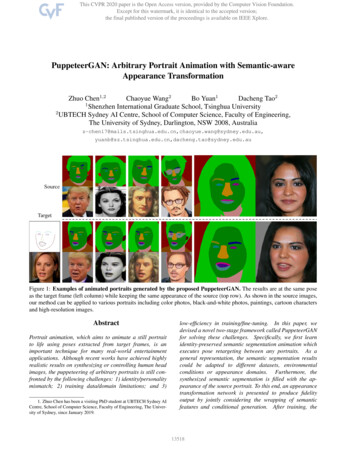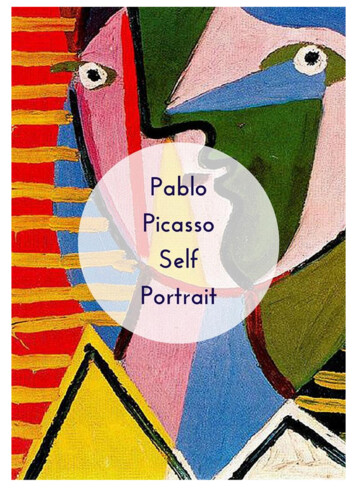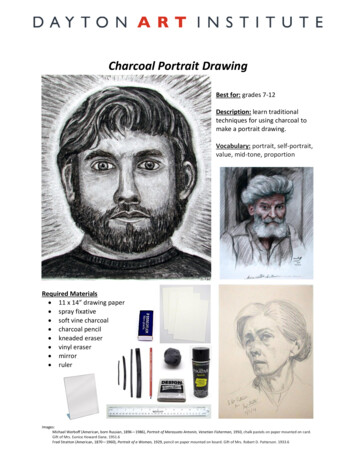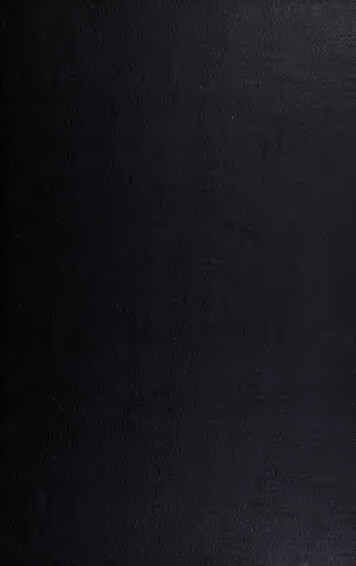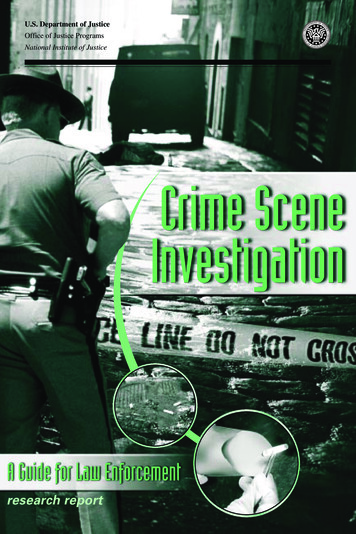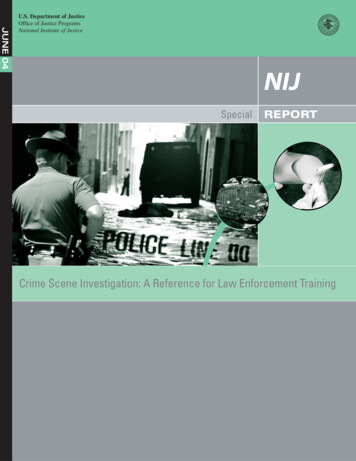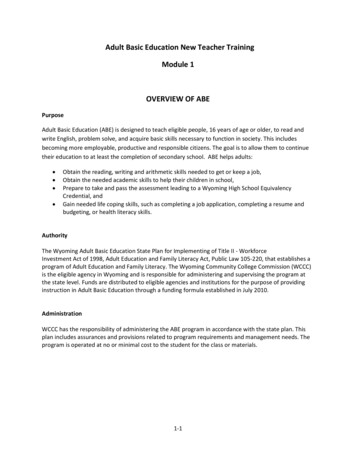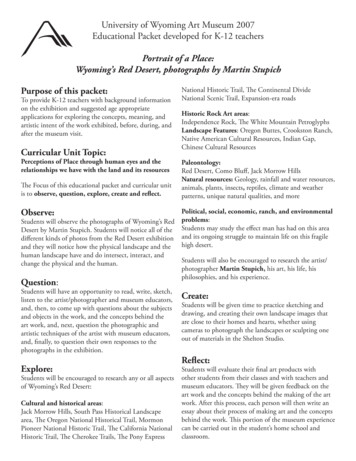
Transcription
University of Wyoming Art Museum 2007Educational Packet developed for K-12 teachersPortrait of a Place:Wyoming’s Red Desert, photographs by Martin StupichPurpose of this packet:To provide K-12 teachers with background informationon the exhibition and suggested age appropriateapplications for exploring the concepts, meaning, andartistic intent of the work exhibited, before, during, andafter the museum visit.Curricular Unit Topic:Perceptions of Place through human eyes and therelationships we have with the land and its resourcesThe Focus of this educational packet and curricular unitis to observe, question, explore, create and reflect.National Historic Trail, The Continental DivideNational Scenic Trail, Expansion-era roadsHistoric Rock Art areas:Independence Rock, The White Mountain PetroglyphsLandscape Features: Oregon Buttes, Crookston Ranch,Native American Cultural Resources, Indian Gap,Chinese Cultural ResourcesPaleontology:Red Desert, Como Bluff, Jack Morrow HillsNatural resources: Geology, rainfall and water resources,animals, plants, insects, reptiles, climate and weatherpatterns, unique natural qualities, and moreObserve:Political, social, economic, ranch, and environmentalStudents will observe the photographs of Wyoming’s Red problems:Desert by Martin Stupich. Students will notice all of the Students may study the effect man has had on this areadifferent kinds of photos from the Red Desert exhibition and its ongoing struggle to maintain life on this fragilehigh desert.and they will notice how the physical landscape and thehuman landscape have and do intersect, interact, andStudents will also be encouraged to research the artist/change the physical and the human.photographer Martin Stupich, his art, his life, hisphilosophies, and his experience.Question:Students will have an opportunity to read, write, sketch,listen to the artist/photographer and museum educators,and, then, to come up with questions about the subjectsand objects in the work, and the concepts behind theart work, and, next, question the photographic andartistic techniques of the artist with museum educators,and, finally, to question their own responses to thephotographs in the exhibition.Explore:Students will be encouraged to research any or all aspectsof Wyoming’s Red Desert:Cultural and historical areas:Jack Morrow Hills, South Pass Historical Landscapearea, The Oregon National Historical Trail, MormonPioneer National Historic Trail, The California NationalHistoric Trail, The Cherokee Trails, The Pony ExpressCreate:Students will be given time to practice sketching anddrawing, and creating their own landscape images thatare close to their homes and hearts, whether usingcameras to photograph the landscapes or sculpting oneout of materials in the Shelton Studio.Reflect:Students will evaluate their final art products withother students from their classes and with teachers andmuseum educators. They will be given feedback on theart work and the concepts behind the making of the artwork. After this process, each person will then write anessay about their process of making art and the conceptsbehind the work. This portion of the museum experiencecan be carried out in the student’s home school andclassroom.
Portrait of a Place:Wyoming’s Red Desert, photography by Martin StupichIntroductionIn this museum experience students will viewthe work of the photographer and artist,Martin Stupich. Martin Stupich has beendocumenting the cultural landscape since1975.Wyoming’s Red Desert is a fifteen thousandsquare mile arid basin in the central RockyMountains. Consisting mainly of stateand federal lands, it is the largest unfencedexpanse in the continental United States; andhistorically it has been an unpopulated, almostunknown, wilderness. Recently discovered,directly beneath it, is one of the world’slargest untapped natural gas reserves. Thedesert’s open-pit and uranium operations arebeing revived in response to world pressures.Surveying, blasting, drilling, and miningaccelerate now at a pace that is transforminginto an industrial landscape.19th century inscriptions on Independence Rock, marking the emmigrants’ passingfrom the Great Plains west into Red Desert country, Sweetwater County, Wyoming2006, Ultrachrome ink on Epson Premium Glossy paper, 13 x 19 in, lent by theartistHistory and BackgroundThis basin straddles the Continental Divide and stretchesacross what is known today as the I-80 corridor. Manywho travel the route between Rawlins and Rock Springsview the barren, high-desert landscape as a featureless,“empty” place with little if any redeeming value.However, the Red Desert is a spectacularly complexplace with delicate microclimates and fragile ecosystems,dramatic geology that offers evidence of its originsand life over eons of time, and a home to wild horsesand desert elk, unique flora and fauna, and, for seventhousand years, human beings.Throughout its life, the region has endured all thatnature and man have given it: droughts and floods, theebb and flow of energy booms, settlements, and a myriadof bisecting and transecting overland routes that includethe earliest pioneer trails, and the first transcontinentalrailroad. Today, it is almost exclusively BLM lands withNational Forests, National Wilderness Study Areas, andNational Recreation Lands.Beneath the Red Desert’s expansive and sparse landscapelie mineral reserves and one of the largest known naturalgas reserves. A time of increased energy demands andchanges in U.S. energy policies makes for an uncommontime in the life of the desert. Over the last two decades,mineral extraction has accelerated dramatically, andmore recently, the tapping of natural gas reserves istransforming the Red Desert from a place of wonder andwildness to one of commodity at an unprecedented pace.Since 2000 Martin Stupich has photographed extensivelyin the Red Desert with an urgency to record it in themidst of its changing. Through his images, we see anexpansive landscape, diverse geology, evidence of theearliest human occupation, boom and bust towns, andpresent day industry. Collectively, a portrait of this placeemerges, revealing the human history of our connectionto the landscape –this landscape. It is a complicatedand fragmented portrait, one that tugs at the perceptionthat this is a barren place of little value and one thatencourages us to look again at the Red Desert in all itswonder and wildness.
Artist StatementsGenesisLessonOverviewStudents willlearn about thework of thephotographerMartin Stupich.They willlearn about hisphotographictechniques,skills, and style.Half of the buildings in Dad, Carbon County, Wyoming 2003, They will learnUltrachrome ink on Epson Premium Glossy paper, 13 x 19 in, lentThe landscape seems stark, the horizonabout howby the artistcrisp and always a day away. The desert ishe came topopulated by scores of herds of rare desertphotograph theelk, wild horse, and antelope. It is home toRed Desert andexotic species of finch, eagle, hawk and owl. Humans live there, why. They will learn about his life and philosophy of art.too, in tiny numbers in small settlements around the basin’s rim. They will learn about diverse aspects of the Red Desert.They will explore the Red Desert from numerous pointsRecently discovered directly beneath the Red Desert is one of theof view. They will explore the land and its resourcesworld’s greatest gas reserves. In the last three years, the empty,and how this area has become a hot-bed of discussion.and remote half-million acres has flipped, transformed in oneStudents will look to see what new and original ideashistoric flash from wilderness steppe to industrial landscape.come from these photographs. Students and teachers willconsider the concepts behind Stupich’s work and whatBritish Petroleum, Halliburton and others have arrived.these concepts mean to us, the viewers.Surveyors, blasting and grading crews, rig operators andgeologists now sweep the basin from edge to edge. CaravansIn the Shelton Studio students will be given theof heavy equipment barrel across pristine playa and mesa,opportunity to work on their own landscape images.leaving a dense crosshatching of new roads in their wake.They will draw and sketch them, paint them, sculptWhat had always been a blank spot on the map is now franticthem, or use a camera to photograph them. While doingwith activity. When the dust clears in a decade or two –afterthis work they will be thinking about all the connectionsthe place has been scraped clean and pumped dry –the boomand issues they have with their own relationships towill end. The gas rigs will move on to the next sweet spot.landscapes.The poisoned water table will begin to recharge. But anyonekeeping time using a clock where a second is a lifetime, will not Students and teachers may research and engage insee the desert heal.conversations about the work of Stupich before arrivingat the art museum, using study guides (available onThe Revelationline) to explore ideas about the Red Desert and thephotographs of the Red Desert. While in the museumIN 2005, after scores of trips crisscrossing the landscape—they will spend time in the galleries closely observingcamping, photographing, documenting, the geography of thisthe work, discussing it, writing about it, and sketchingwondrous raw place—it hit me like a skillet. They are notit. They will begin conversations on the techniques youplundering the place. We are. I am. I look down to see thatmight use to photograph a landscape you feel deeplymy tracks in the dust merge with theirs. They maybe miningabout and more conversations about issues surroundingthe coal and poisoning the groundwater, but they do it in ourname. I am accomplice and beneficiary. Now what? Do I turn that landscape. These conversations will hopefully laythe groundwork for future opportunities to pursue thesemyself in—and to whom?ideas in their home classrooms and schools. —excerpt from Martin Stupich’s essay inFOTOFEST 2006 catalogueIn 1996, a mountain bike crash in thecentral Rockies gave me a titanium femurand a sudden intimate relationship withthe southern Wyoming landscape. Withina year of ditching my crutches, I movedfrom Boston and using John McPhee’s‘Rising from the Plains’ as my atlas,settled on the edge of the high windyGreat Divide Basin in Wyoming RedDesert country.
Essential QuestionsGrades K-6 What do you see in these photographs? (Pick yourfavorites, 3-5 photographs, since there are over 70 ofthem.) Make a list of all you see. What looks new in the photographs? What looks old in the photographs? What do you think about the photographs after youread the text next to each image? Does it change yourperceptions of the photographs in any way? How do we know if the photographs are beautiful?What is it that makes them beautiful? How do we know if the photographs are unappealingor not beautiful? How is that so? What objects in the photographs are manmade? What in these photos of landscapes looks or appears tobe pristine or untouched by man? How do Nature and Human affect each other in thephotos? What makes these photographs works of art?Grades 7-12 How does the visual landscape affect our ideas of whatart is? How does a close physical relationship with the landinfluence our ideas of art and the world? Does this exhibition give you a ‘portrait’ of the RedDesert? Explain. Does viewing and observing the photographs closelymake you want to find out more about the Red Desert? Do you want to go to the Red Desert after seeing thephotographs? If you have been to the Red Desert and you know itquite well, how do you feel about the perspective thisartist takes in these photographs? What do these photographs make you think about? What do these photographs make you feel? Do you know about the cultural and historical areas inthe Red Desert? Do you know about high desert eco-systems and theirevolutionary processes? Do you want to know more about the Red Desert? What do you think Martin Stupich is saying to usthrough his photographs? Does this exhibition make you want to photograph alandscape or place dear to your own heart? Do you want to sketch, sculpt, paint, or write about aspecial place? What other ways could you express the way you feeland think about a special place?Off road vehicle tracks and hill, Moffat County, Colorado 2006,Ultrachrome ink on Epson Premium Glossy paper, 20 x 30 in, lentby the artistArt questions to consider What is appealing to you about the photographs?Composition, forms: linear and circular, colors,contrast, textures, lines, perspective and symbols?What is unappealing to you about the photographs?Composition, forms: linear and circular, colors,textures, lines, perspective and symbols?What is missing from the photographs, if anything?What patterns do you find in the photographs? Arethere any?Are the photos in focus or out of focus?Do you see any repeated images, colors, textures,objects, etc.?Does the photographer shoot his images close-up, ata distance, from above, from below, from side angles?Do you think Martin Stupich has changed any of theoriginal images digitally?Has he removed anything or added anything?Pre-visit ActivitiesIn order to prepare students for their museum visit andextend learning possibilities, we suggest that teachers andstudents consider the following activities. Students will read and research about the RedDesert in magazine articles, in books, on theinternet, or in newspapers. Students will choose specific cultural and/orhistorical areas in the Red Desert to research. Students will research the ecology of the fragilehigh Wyoming desert.
Students will research the photographer, MartinStupich, and his techniques and philosophy ofphotography.Students will research photographic techniques.Possible Areas of research: Jack Morrow HillsBoar’s TuskKillpecker DunesSteamboat MountainHoneycomb ButtesAdobe TownSouth Pass Historic Landscape AreaThe Oregon national Historic TrailMormon Pioneer National Historic TrailThe California National HistoricThe Cherokee TrailsThe Pony Express National Historic TrailThe Continental Divide National Scenic TrailExpansion-era roadsIndependence RockThe White Mountain PetroglyphsOregon ButtesCrookston RanchNative American Cultural ResourcesIndian GapChinese Cultural ResourcesPaleontologyComo BluffNatural and biological resources in the RedDesert:o Big Gameo Endangered Specieso Vegetation typeso Wetlandso OthersOil and gas resources in the Red DesertPrerequisite skills/knowledgeMuseum staff will work with teachers to ensure that allprojects are age and skills appropriate. At thevery minimum: Students should have some familiaritywith sketching and drawing objects. Students should know how to use asimple camera. It would be helpful if students read somehistory and biology of the Red Desert. Students can look up the vocabularywords below:Vocabulary to know adaptationarchivesbasincoal bed-methanecoal seamcommodityContinental Dividecontrolled burncreekcross country gas pipelinecultural landscapedroughtecosystemEndangered speciesenergy historic l extractionnatural gasopen pit mineperceptionpioneerportraitpower tationwetlandswildernessTrench with forty-two inch gaspipeline, capped, near WalcotJunction, Carbon County, Wyoming2006, Ultrachrome ink on EpsonPremium Glossy paper, 13 x 19 in,lent by the artist
Gas pad marker from 1970s, shapedlike the ill-fated Super sonic transportof that era, west of Dad, CarbonCounty, Wyoming 2003, Ultrachromeink on Epson Premium Glossypaper, 13 x 19 in, lent by the artistMuseum activitiesPart 1 – Time frame: 45minutes Students will closely observe thephotographs of Martin Stupichin the gallery.Students will be given aworksheet so they can respondin writing or drawing to the work they see byrecording their observations and their ownthoughts about the work.Students will discuss what they see with museumeducators.They will explore the history and evolution ofthe Red Desert, and the relationships with man,which have changed both man and the RedDesert.They will explore the perspectives from whichthe photographer, Martin Stupich shot thephotos.Students will answer questions on a museumworksheet.Students will develop questions on a museumworksheet.Students will engage in discussions about theirobservations and their answers, questions, andsketches with one another and with the teachersand artist/s.Part 2 – Time frame: 45 minutesThe following projects may be consideredindividually, or combined, or museum staff willwork with teachers to develop specific projects whichsupport ongoing classroom work. Students will explore the idea of place andlandscape by either photographing, drawing,painting, using pastels, printmaking, orsculpting a landscape they know well. Students will create a drawing, painting, photo print or sculpture with a specificlandscape of their choice in mind.Students will explore techniques in themaking of a photograph, a drawing,painting, or sculpture.Post-visit activitiesWe have found that students achieve maximum benefitfrom a museum visit when time is scheduled for postvisit activities. Here are some suggestions: Students might consider writing a paper usingthe Red Desert as Metaphor. Most folks driveby the Red Desert on I-80 and think that thereis nothing there, nothing to see, nothing toexperience or learn about. Like the desert somestudents feel like other kids at school walk bythem every day and never really “see” them or“know” them. Students could write about hownobody at school really knows much about themand they could explore their own histories. Students discuss or write about their museumexperiences, reviewing what they have learned,what has special meaning for them, and howthey will use new information and skills. Students continue to research the work of thephotographer, Martin Stupich. Students research other landscape photographers. Students continue to research one or moreaspects of the Red Desert. Students continue to research and explorephotography.
Suggested use in the curriculumThe study of Martin Stupich’s Portrait of a Place:Wyoming’s Red Desert, and its historical, cultural, artistic,biological, and geological aspects will tie to multiplecurricular areas, including; the study of geography, thearts, math, science, history, English, reading and writing,debate, anthropology, and philosophy. Museum staffwill work with teachers to address specific WyomingTeaching Standards and to align museum projects andstudies with ongoing classroom curricular units.Some recommended resourcesClifford, Hal, “Methane to their Madness.” Grist.org 09Jan. 2002 http://www.grist.org/Library/reports.cfm Clifford, Hal, “The Last Lonesome Place.” OnEarth 22Sept. 2002, Vol. 24., Natural Defense Council, Inc.Western EcoSystems Technology, Inc., Cheyenne,Wyoming. “Resources of the Red Desert and the JackMorrow Hills.” http://www.reddesert.org/documents/west report.pdfOn-line sources:Agricultural Research zon has a selection of government documents onthe Red Desert for sale.Biodiversity Conservation AllianceContact: erik@voiceforthewild.orgBureau of Land Management: Wyoming Officeswww.blm.gov/wy/st/en.htmlFriends of the Red DesertContact: info@reddesert.orgMountain Prairie Information Node http://mpin.nbii.gov/portal/server.pt?open 512&objID 234&PageID 281&cached true&mode 2&userID 2Provides Geographically-based information atregional, state, and other scales; thematically organizedinformation concerning topics of regional interest; toolsand processes that facilitate data integration.Wyoming Game and Fishwww.gf.state.wy.usWyoming Outdoor CouncilContact: bpendery@pcu.netWyoming WildlifeContact: joyowen@wyomingwildlife.orgMaterials to be supplied to each studentMaterials for selected Shelton Studio projects areprovided by the art museum.Assessments and documentation ofmuseum tour and studio experiencesIn order to ensure that our museum tour program ismeeting the needs of teachers and students, we ask thatparticipants complete evaluation surveys. Surveys willbe distributed to teachers and students, but they are alsoavailable on-line as a pdf file to be downloaded, or theymay be requested via e-mail (wbredehoft@uwyo.edu).1. Students will self-assess using a quick surveythat asks them to consider their response to thegallery discussions and research, and their studioexperience.2. Teachers will assess the overall visit bycompleting a quick survey that asks for theirobservation and assessment of students’experiences, as well as assessment of the overallprocess of the museum visit.3. Museum staff and artists/teachers will recordtheir observations and assessments.4. When studio time permits, we will ask studentsto briefly discuss their art work completed in theShelton Studio visit.5. Museum staff may take photographs of studentsand teachers to document the learning takingplace and the work produced during a museumvisit. These are available upon written requestto teachers who would like to use them as art ofteaching and student portfolios.
Portrait of a Place: Wyoming’s Red Desert, photographs by Martin Stupich . artistic techniques of the artist with museum educators, and, finally, to question their own responses to the . Students will b



